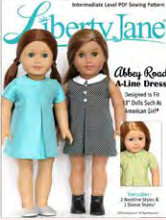10.11: Case study - Pixie Faire
- Page ID
- 41775
One-line summary
How one couple is making US $600 000 per year selling digital products.

The challenge
Cinnamon and Jason Miles started making and selling dolls’ clothes online. Cinnamon was an excellent seamstress who made unique and beautiful clothes for her daughter to use with her dolls. After being inundated with queries on where they got these clothes, Cinnamon and Jason started Liberty Jane Clothing selling dolls’ clothes online, initially through eBay and then through their own eCommerce website on WordPress.
Unfortunately, their business model was not very scalable and they struggled to meet demand and break through earning US $1 000 a month. Cinnamon was maxed-out creating all the clothing herself, and having local seamstresses assist, also did not work on any scalable level. They declined the offer of getting their products made in China, as they wanted to retain manufacturing control and guarantee the integrity of their product.
The solution
Selling the physical products alone simply wasn’t scalable, so Cinnamon and Jason looked at what digital products they could sell. They hit on selling their doll patterns as downloadable PDFs, which users could purchase and use to create their own doll clothes. This model scaled well, and to date have had over 700 000 pattern downloads.

They also noticed a gap in tuition of how to actually create the clothes, so they started online classes and videos to train users on how to make the clothes with the patterns. The online training courses grew to include design, pattern-making and how to start and manage your own craft business.
They also broadened their business model to become the Internet’s largest marketplace for dolls’ clothing patterns, and feature other indie designers. Designers have to be approved by Cinnamon and Jason to sell through the site. They renamed their site Pixie Faire, but kept the Liberty Jane Clothing brand for their own doll clothing and patterns. They use a store-level pricing strategy that all designers have to comply with, similar to that of iTunes and Kindle, to keep prices at acceptable levels.
With increased demand, visits and purchases, the WordPress site struggled. Even with the shopping cart functionality the platform was simply ill-prepared to manage the volume that Pixie Faire was now dealing with. Opting for platforms that were designed to manage eCommerce specifically , such as Shopify and SendOwl, really helped to remove much of the frustration the company had experienced with its online sales. The peace of mind and ease that was provided by going the route was invaluable.
Results
Pixie Faire now generates over US $600 000 a year, with an average monthly return of US $50 000. This is only possible due to their move into digital products and using a platform designed to cope with the demands of larger volumes of traffic.
A physical tangible product that required so much hands-on attention simply was not scalable. Cinnamon and Jason needed an alternate digital product to provide the scale for their revenue to totally explode beyond their expectations. Careful consideration of your product and offering is necessary when determining your eCommerce needs and capabilities. (Schreiber, 2015)
This study also demonstrates the need to choose an eCommerce platform that will be able to manage with the demands of your business, should it take off. Problems with check out and crashing lead to a poor user experience that may put off potential customers. Planning your product strategy and selecting appropriate platforms are essential to eCommerce success.


